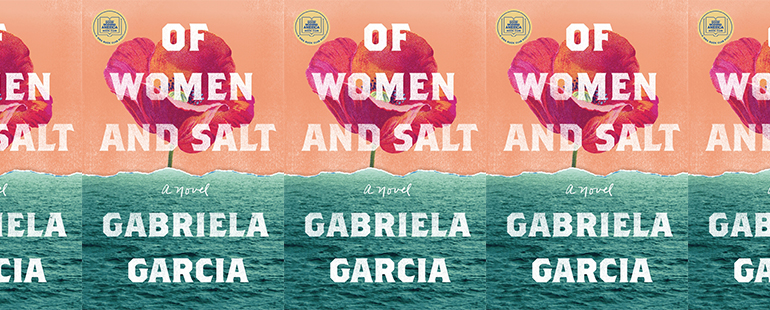“A lot of the novel is about stories—the ones we tell ourselves about ourselves, the ones we don’t know but that shape us in some way”: An Interview with Gabriela Garcia

Written by the daughter of immigrants from Mexico and Cuba, Gabriela Garcia’s Of Women and Salt digs into issues of cultural identity, social and political unrest, and the complexities of lives informed by migration, oppression, and racial inequality. Spanning countries and generations, the novel is full of pride and beauty, and gives us a vibrant perspective on what it means to challenge and change one’s sense of belonging. With a non-chronological narrative built on glimpses of memory and history, Of Women and Salt is a bright, engaging debut of depth and texture.
The earliest scenes in the novel take us to Cuba in 1866, where María Isabel works as the only woman in a cigar rolling factory. There, to pass the time for the workers, a lector reads the news from La Aurora as well as selections from Alexander Dumas, William Shakespeare, and Victor Hugo. María endures regular nosebleeds from the tobacco dust as well as misogyny from her male supervisors, but through the lector’s reading of Les Misérables, she begins to see the possibility of change and of class justice, the ability to rebel. Simultaneously, a social revolution is mounting all around her; Hugo publishes a public letter to the workers of Cuba: “Who are we? Weakness?” he asks. “No, we are force.” From these inspirational words, María begins a journey toward self-empowerment, one that will be paralleled in future generations of her family.
María’s granddaughter Dolores finds oppression much closer to home, living under an abusive husband. In 1950s Cuba, Dolores rises up against this injustice, just as her grandmother did, believing that she too is force. She will not be abused by her husband. She will fight back. The manner in which she frees herself is aggressive, and this creates a rift with her daughter Carmen, ultimately leading to a severing of their relationship. A century after María’s story, oppression remains, and even though her family will always fight back, victory often comes with a mixture of hope and sorrow, Dolores’s escape creating unintended ripples in her relationship with her own child.
Much later, Carmen, grown and living in Miami, still doesn’t speak with Dolores, and her daughter Jeanette wants to know why. A recovering drug addict, Jeannette is eager to redefine herself and to renew her identity, and she wants this renewal to be grounded in the cultural heritage of her family; her mother, however, refuses to relate what happened during her childhood. Because of this refusal, Jeannette makes plans to visit Cuba for the first time, intent on tracking down the answers for herself. As she tells her mother, “I want to know who I am, so I need to know who you’ve been.” Here, in the face of both societal and individual strain, family and culture is the sought-after modifier, the means to set things right, even when it is difficult to face.
Of Women and Salt also brings in another family’s migration story, that of Jeanette’s neighbor Gloria. Gloria immigrated to the United States from El Salvador and is hard at work on a new life for herself and her daughter Ana. This intersecting storyline brings a further illustration of oppression and injustice when Gloria is snagged midday by the INS and sent to a detention facility, leaving Ana to come home from school to a locked and empty apartment. Jeanette briefly takes the girl in, and, during this encounter, comes to realize how racial inequities loom across all cultures, and how hard it can be to tell stories of inequity, even to those we love. Through Ana, Jeannette begins to understand her mother’s difficulty in sharing her childhood. Ana is taken into INS custody a few nights later, and while she is reunited with Gloria, they are deported to Mexico instead of their home country, forced again to start in a new world. Gloria and Ana’s plight magnifies Jeannette’s severed relationships, so when she lands in Cuba to unravel the mysteries of her own lineage, she has greater empathy for her family’s struggles: “We grew up on opposite shores but equally drenched in the political, in living everything through the context of a country miles away. I understand her fatigue. I, too, am tired.”
Of Women and Salt is a novel built on individual rebellions against injustice that are both adamant and insightful, and in their cross-cutting stories, the similarities are amplified. In the end, Garcia resists any easy conclusions. The lives of her characters don’t end idyllically. Instead, they end as life often does: with pain and longing, loss and hopefulness, regret and peace. They end telling us more about how we endure than how we escape. As is written in the margins of María’s Spanish language edition of Les Misérables, handed down through the generations, the fight for equality and social justice inspires each of them: “We are force, the scribble read. And then Jeanette had added her own words, We are more than we think we are.”
J.A. Tyler: This novel gave you the opportunity to write about 1800s Cuba and present-day Miami, 1950s Cuba and contemporary Mexico. What was it like, knowing you’d set yourself up to access such a wide range of places, people, and eras?
Gabriela Garcia: I enjoyed looking at each of my characters through the prism of other characters, other generations, other stories in conversation with each other. I don’t normally write much historical fiction, and even though the majority of the novel is set in contemporary times, those forays into a more distant past were an interesting challenge. Writing them felt like writing under a kind of formal constraint in a way, writing within certain researched boundaries.
JAT: Instead of starting in 1866 and moving chronologically, the novel jumps from century to century, character to character. What was the impetus to rearrange time and stories in this fashion?
GG: I knew I didn’t want to write in a linear, traditional Western storytelling mode, and also that I wanted to experiment with shifts in style and tone and voice. I’ve always admired writers who can write well in wildly different modes. I love when I read a story collection, for example, and can’t believe the stories were all written by the same author. And I was thinking a lot about how memory functions, how stories function, what is knowable and unknowable. It made sense to me to shape the novel as these glimpses that start to illuminate different aspects of each other as the novel moves forward.
JAT: How does Of Women and Salt grapple with that notion of knowable versus unknowable?
GG: The way history works, whether it’s personal history or a larger political history, is that we have access to only certain details through specific lenses. We can never get the full truth because only certain stories are deemed important enough to pass down. And what is deemed important and how it is framed depends on who is telling the story, who has access. And that’s happening throughout the book with each of the characters—they have access to stories, sometimes stories they’ve told themselves, that are limited in scope, that are not the full picture. And often they are looking at each other without really seeing each other, because of what is left unsaid, what is unknowable, and how every life experience colors what becomes one character’s truth.
JAT: Which character came first for you when drafting the novel? And in the end, whose voice was the loudest on the page?
GG: I wanted all of the voices to be women’s voices. I think the first character I wrote was one of the first to appear in the novel, María Isabel. And in the beginning, I wasn’t sure if there was going to be one character around whom the novel centered, but I kept coming back to Jeanette.
JAT: Why do you think María Isabel’s voice arrived first, and where does that character’s strength emanate from?
GG: Perhaps she came first because I was trying to envision a beginning point to an intergenerational narrative. So much has been written about the Cuban revolution of 1959, and I was thinking I wanted to widen the scope, start from a failed revolution in the 19th century, and center women in those spaces of revolutionary masculine mythos.
JAT: What was the pull to consider Jeanette as a possible center?
GG: She seemed like the hinge for a lot of the relationships. But perhaps she was also the easiest character to inhabit because in some ways she is similar to me—a first-generation daughter of immigrants growing up in Miami. We’re quite different, but there were certain ways that it was easier to imagine her perspective.
JAT: Which characters in the book were more difficult to articulate?
GG: Honestly, all of the characters were challenging, because they are all women who are flawed in their own ways, often choosing differently than I would or acting in a morally questionable manner. I wanted to see all of these women in their full humanity and complexity, and sometimes that meant going to some difficult places.
JAT: How was this book partially informed by your own first-generation experience as well as your parents’ respective stories?
GG: There are glimmers of myself in every character, although I’m quite different from any of them. And growing up the daughter of Cuban and Mexican immigrants made me aware of the racial and class divisions that exist within immigrant communities and that the idea of a monolithic Latinx identity is a myth, which certainly influenced how I conceived of this novel that is about two very different immigrant families whose lives intersect. But my parents are also quite different from either of these families.
JAT: Will your next book connect with this experience too, or will it take us elsewhere?
GG: I have no idea where I will go with my next book! I’ve been working on shorter projects, mostly poems and short stories during the pandemic, because I’ve struggled to concentrate on anything at all. I hope that when I do find the mental space to work on another book, it’ll be something that takes me in new directions and keeps me growing as a writer.
JAT: Has that struggle to concentrate also bled into your reading life? Have you been able to stay connected to reading as you would under normal circumstances?
GG: In the early days of the pandemic I really struggled. I’m usually a fast reader, but I found myself reading the same passages over and over, unable to concentrate. Finishing any book felt miraculous. I’ve started to get back into my flow, and I’m so grateful. For a while I felt like, am I even a writer still? A reader?
JAT: In the end, how does Of Woman and Salt break, bend, or flex the notion of “happily ever after”?
GG: A lot of the novel is about stories—the ones we tell ourselves about ourselves, the ones we don’t know but that shape us in some way, who gets to tell them, how they are or are not passed down. And that “happily ever after” can exist for anyone is a story, a mythology. The novel ends on what could be thought of as a happy moment—a birthday cake, a gift. But the narrator is clear that it’s a moment, that there will be other moments. And that’s life, right? Emotion is always conditional. We find flickers of happiness, of sorrow, we struggle sometimes to disentangle the two. All there can be is an “after.”
JAT: What are some of your favorite immigration-related novels?
GG: A recent favorite is Roberto Lovato’s memoir Unforgetting, which traces years of activism and reporting on migration and U.S.-sponsored violence in El Salvador interwoven with a deeply personal story of family reckoning. And I was immediately excited when I picked up Juli Delgado Lopera’s novel Fiebre Tropical, about a teenager navigating desire for an evangelical pastor’s daughter as her family cracks in suburban wasteland Miami and told in fuck-any-other-gaze Colombian Spanglish.



